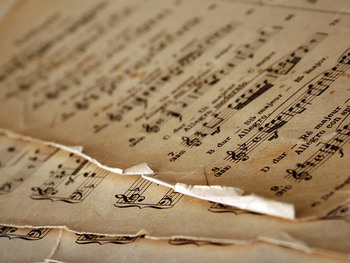Music Throughout History: Influence During Time periods
As times change, so does music accordingly. Time periods of music were greatly influenced by events going on in the world at that time. Music is still influenced by society today. The six major periods of music are Middle Ages, Renaissance, Baroque, Classical, Romantic, and 20th Century, each with its own unique sound. These eras of music reflect changes in society and culture that effected the way music sounded and was created.
(You may want to listen to an example of the music while you read by clicking on the youtube video below each passage.)
(You may want to listen to an example of the music while you read by clicking on the youtube video below each passage.)
Middle Ages (450-1450)
During the Middle Ages, the spread of Christianity was a main influence on music. The church was a very important part of life, therefore being very important to music. Church was the focal point of learning, social life, and the arts. European culture was developing and Islamic culture also influenced culture. Music was mainly music of the Church. Polyphony was born. Polyphony is a texture consisting of two or more independent melodic voices, as opposed to music with just one voice (monophony) or music with one dominant melodic voice accompanied by chords (homophony).(wikipedia) The pope from 590-640, St. Gregory, organized huge christian church chants, thus giving it the name "Gregorian Chant." Gregorian Chant is monophonic, having one melodic line with no accompaniment.
Renaissance (1450-1600)
The Renaissance was a time of rebirth of classical ways. Many people's views on the world were changed. As a cultural movement, it held a reviving of learning based on classical sources, the development of linear perspective in painting, and gradual but extensive educational reform. During this time there was an increased interest in human learning and an increased patronage of music. There was also territorial expansionism and increased wealth. Artists and musicians produced works that displayed more artistic freedom and individualism. By being creative and free, they abandoned the more structured ways of the Medieval Era. There was a distinctive, harmonious, polyphonic style. Many new instruments were invented and existing instruments were enhanced.
Baroque (1600-1750)
During the Baroque Era, there was an increasing importance of scientific investigation. The New World was developing. Artificiality was greatly valued in the arts. This was a time for experimentation and expanded the roles of music. There was a growing awareness of nationalistic styles.The term Baroque was rooted from a Portuguese word that means "a pearl of irregular shape." At first, the word Baroque was used to describe strangeness, abnormality and extravagance. This applied more to art than it did to music. Baroque was considered an intense change from previous styles of music. The music of this period has a number of defining characteristics. The use of the basso continuo, a bass part written out in full and accompanied by numbers to indicate the chords to be played, and the belief in the doctrine of the affections, which allowed composers to express emotions and feelings in their compositions, are two common characteristics. There is an extreme emphasis on volume, texture, and pace. Baroque music used the power of the voice to convey emotion and color. Musical works containing a continuo part in which a keyboard and a bass instrument helped to convey the harmonic support of chords under the melodic lines. Opera and the orchestra were both conceived during the Baroque era.
Classical (1750-1825)
This era of music was during the Industrial revolution and the philosophy of the Enlightenment. The time period was influenced by the political ideals of Republican government. The music was influenced mainly by art and the concept of nature in the arts. The style consisted of simpler textures and melodies. Many instruments (mainly wind) were added to the typical orchestra, which gave works more color. The style was dominated by homophony, which consisted of a single melodic line and an accompaniment. The melodies of the Classical era were more compact and involved only notes proper to the prevailing key without chromatic alteration. Harmony was less structured. The four major composers of the Classical era were Haydn, Mozart, Gluck, and Beethoven.
Romantic (1825-1900)
During the Romantic time, there was an increasing importance of science, a rise of nationalism in Europe, and a growing self-determination for the arts. In music, there was an increased interest in nature and the supernatural. Nationalism and exoticism were perceived through music. It was a period of emancipation and great change. The Romantic era moved away from the strict laws of balance and restraint of the Classical era by allowing artistic freedom, creativity, and experimentation.
20th Century (1900-present)
Historical Themes
With the coming of the 20th century another evolution in the musical world emerged.
- Phenomenal changes in technology
- The advent of instantaneous global communications
- The growth and eventual decline of totalitarian culture
- Ambivalent attitudes toward the musical past
- A widening gap between "art" and "popular" music
- The advent of sound recording
- The birth of a "World Music" culture
With the coming of the 20th century another evolution in the musical world emerged.

